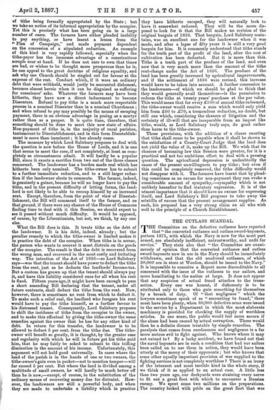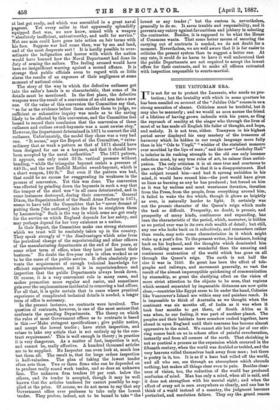THE CUTLASS SCANDAL.
THE Committee OD the defective cutlasses have reported that "the converted cutlasses and cutlass sword-bayonets, pattern 1871, with which the Navy is now for the most part armed, are absolutely inefficient, untrustworthy, and unfit for service." They state also that "the Committee are unani- mously of opinion that the converted cutlasses and cutlass sword-bayonets now in use in the Navy should be immediately withdrawn, and that the old unaltered cutlasses, of which 30,000 are in store at Weedon, should be issued to the Navy." It is impossible to conceive a Report more discreditable to all concerned with the issue of the cutlasses to our sailors, and more humiliating to the nation at large. It does not appear that any suspicion of actual fraud attaches to the trans- action. Every one was honest, if dishonesty is to be attributed only to those who gain something for themselves by a breach of duty. Of "that negligence" which the lawyers sometimes speak of as "amounting to fraud," there must have been plenty, when 80,000 defective arms were issued to the service by a Department in which the most elaborate machinery is provided for checking the supply of worthless articles. In one sense, the public would feel more secure if the abuse had been caused by actual corruption. There would then be a definite disease treatable by simple remedies. The paralysis that comes from carelessness and negligence is a far more serious evil to fight against. Who knows where it may not extend to I By a lucky accident, we have found out that the naval bayonets are in such a condition that had our sailors been called on to use them in action, they would have been utterly at the mercy of their opponents ; but who knows that some other equally important provision of war supplied to the fighting services is not completely worthless There is an irony of the intensest and most terrible kind in the whole story, if we think of it as applied to an actual case. A little less than two years ago, our dockyards were straining every nerve to fit out a great fleet with which to encounter a Russian enemy. We spent some two millions on the preparations. The country looked with pride on the great fleet that was at last got ready, and which was assembled in a great naval pageant. Yet every sailor in that apparently splendidly equipped fleet was, we now know, armed with a weapon "absolutely inefficient, untrustworthy, and unfit for service." Not one man could have gone into action on fair terms with his foes. Suppose war had come then, war by sea and land, and of the most desperate sort ! It is hardly possible to over- estimate the indignation and horror with which the nation would have learned how the Naval Department had done its duty of arming the sailors. The feeling aroused would have been no insignificant warning against a second offence. It is strange that public officials seem to regard with so little alarm the results of an exposure of their negligence at some moment of national crisis.
The story of the way in which the defective cutlasses got into the sailor's hands is so characteristic, that some of its details must be mentioned. In the first place, the defective weapons were the result of a conversion of an old arm into a new one. Of the value of this conversion the Committee say that,
so far as the evidence before them enables them to judge, no sufficient or exhaustive inquiry was made as to the saving likely to be effected by this conversion, and the Committee feel bound to record their conclusion that the conversion of these cutlasses and cutlass sword-bayonets was a most unwise step." However, the Department determined in 1871 to convert the old cutlasses. Unfortunately, the model they chose was a very bad one. "It seems," says the Report of the Committee, " extra- ordinary that so weak a pattern as that of 1871 should have been designed for use as a bayonet, and that it should have been accepted by the naval authorities." The 1871 pattern, it appears, can only resist 32 lb. vertical pressure without bending, "while the triangular bayonet resists a pressure of 440 lb., and the new Enfield Martini sword-bayonet, which is a short weapon, 160 lb." But even if the pattern was bad, that could be no excuse for exaggerating its weakness in the process of conversion. Yet this was done. The conversion was effected by grinding down the bayonets in such a way that the temper of the steel was "in all cases deteriorated, and in some instances destroyed, during their conversion." General Dixon, the Superintendent of the Small Arms Factory in 1871, seems to have told the Committee that he "never dreamt of putting them [the cutlasses] into the fire to straighten them by hammering." Such is the way in which arms ale got ready for the service on which England depends for her safety, and may perhaps depend for her very existence as a nation.
In their Report, the Committee make one strong statement which we trust will be resolutely taken up in the country. They speak strongly of "the disadvantages which arise from the periodical change of the superintending and other officers of the manufacturing departments at the end of five years, or some other term of office, when they have just learnt their business." No doubt the five-year rule is often worked so as to be the curse of the public service. It often absolutely pre- vents the acquirement of enough technical knowledge for efficient superintendence, and it is in superintendence and inspection that the public Departments always break down. Of course, it is a very convenient rule in many cases, and makes promotion more regular and easier, and sometimes gets over the unpleasantness incidental to removing a bad officer. For all that, it is quite certain that in cases where practical experience of complicated technical details is needed, a longer term of office is necessary.
In the present instance, no contracts were involved. The question of contracts, however, is one of the most serious that confronts the spending Departments. The theory on which the roles of most Government offices as to contracts is based
is this Make stringent specifications ; give public notice, and accept the lowest tender ; have strict inspection, and refuse to take any article that is not entirely up to the con- tract requirement.' This is well enough in theory ; in practice it is very dangerous. As a matter of fact, inspection is not, and cannot be, really effective. A hundred thousand articles are to be supplied. No Inspector can even look at, much less test them all. The result is, that for large orders inspection is half-valueless. The plan of taking the lowest tender often acts thus. Two or three firms who can be depended on to produce really sound work tender, and so does an unknown arm. The unknown firm tenders 10 per cent, below the others, and its tender is accepted, though it may be well known that the articles tendered for cannot possibly be sup- plied at the price. Of course, we do not mean to say that any Government office ever professes to take only the lowest tender. They profess, indeed, not to be bound to take "the lowest or any tender ;" but the custom is, nevertheless, generally to do so. It saves trouble and responsibility, and it prevents any outcry against favouritism and jobbery in selecting the contractor. Besides, it is supposed to be what the House of Commons wants. That some better means of securing the carrying out of contracts is needed, we do not doubt for a moment. Nevertheless, we are well aware that it is far easier to criticise the present system than to suggest a better one. At any rate, it could do no harm to have it well understood that the public Departments are not required to accept the lowest offers for their contracts, and to make all officers entrusted with inspection responsible to courts-martial.



































 Previous page
Previous page